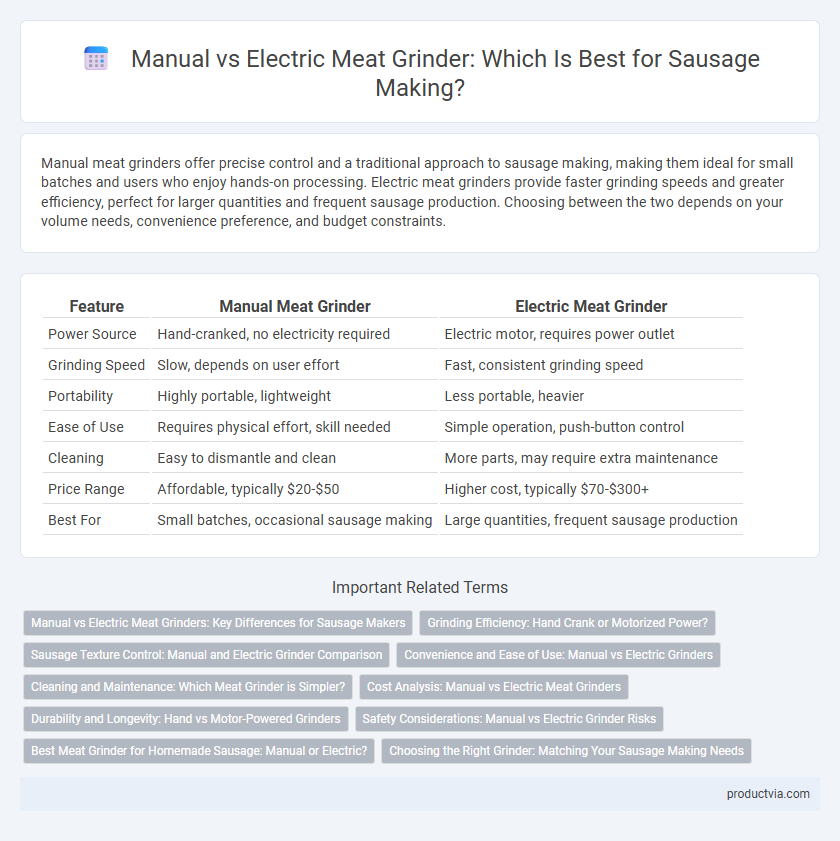Manual meat grinders offer precise control and a traditional approach to sausage making, making them ideal for small batches and users who enjoy hands-on processing. Electric meat grinders provide faster grinding speeds and greater efficiency, perfect for larger quantities and frequent sausage production. Choosing between the two depends on your volume needs, convenience preference, and budget constraints.
Table of Comparison
| Feature | Manual Meat Grinder | Electric Meat Grinder |
|---|---|---|
| Power Source | Hand-cranked, no electricity required | Electric motor, requires power outlet |
| Grinding Speed | Slow, depends on user effort | Fast, consistent grinding speed |
| Portability | Highly portable, lightweight | Less portable, heavier |
| Ease of Use | Requires physical effort, skill needed | Simple operation, push-button control |
| Cleaning | Easy to dismantle and clean | More parts, may require extra maintenance |
| Price Range | Affordable, typically $20-$50 | Higher cost, typically $70-$300+ |
| Best For | Small batches, occasional sausage making | Large quantities, frequent sausage production |
Manual vs Electric Meat Grinders: Key Differences for Sausage Makers
Manual meat grinders require physical effort and operate without electricity, making them ideal for small batches and outdoor use. Electric meat grinders offer greater speed and consistency, efficiently handling larger quantities of meat for sausage making. Choosing between manual and electric grinders depends on volume, convenience, and portability needs.
Grinding Efficiency: Hand Crank or Motorized Power?
Manual meat grinders provide precise control over grinding speed and texture, ideal for small batches and delicate sausage making, but require more time and physical effort. Electric meat grinders offer significantly higher grinding efficiency with powerful motors that quickly process large quantities of meat, ensuring consistent texture essential for uniform sausages. Choosing between hand crank and motorized power depends on the balance between desired grinding speed, batch size, and physical exertion tolerance during sausage production.
Sausage Texture Control: Manual and Electric Grinder Comparison
Manual meat grinders offer precise control over sausage texture by allowing users to adjust grinding speed and pressure, resulting in a coarser or finer grind tailored to specific recipes. Electric meat grinders provide consistent and efficient grinding, ideal for uniform sausage texture, but may sacrifice some customization in texture control due to fixed grinding speeds. Choosing between manual and electric depends on whether texture customization or processing speed is prioritized for optimal sausage making.
Convenience and Ease of Use: Manual vs Electric Grinders
Manual meat grinders offer precise control and require no electricity, making them ideal for small batches and on-the-go sausage making, but they demand more physical effort and time. Electric meat grinders significantly speed up the grinding process with powerful motors and automated operation, enhancing convenience for larger quantities and frequent use. Choosing between manual and electric grinders depends on user preference for hands-on control versus efficiency and ease during sausage preparation.
Cleaning and Maintenance: Which Meat Grinder is Simpler?
Manual meat grinders require disassembly and thorough handwashing of individual components to prevent meat residue buildup, making the cleaning process more time-consuming. Electric meat grinders often feature detachable parts dishwasher-safe or designed for easy rinsing, streamlining maintenance and reducing downtime between uses. Regular lubrication and prompt cleaning are essential for both types to ensure longevity and optimal performance during sausage making.
Cost Analysis: Manual vs Electric Meat Grinders
Manual meat grinders typically cost between $20 and $50, making them an affordable option for occasional sausage making, while electric meat grinders range from $100 to over $300, reflecting their higher power and efficiency. Manual grinders require more physical effort and time, which can impact overall labor cost and productivity during large batch sausage production. Electric grinders offer faster processing speeds and consistent grinding quality, justifying the higher initial investment for frequent or commercial sausage makers seeking long-term cost savings.
Durability and Longevity: Hand vs Motor-Powered Grinders
Manual meat grinders typically offer greater durability due to their simple, sturdy construction with fewer mechanical parts prone to wear, making them ideal for long-term use in sausage making. Electric meat grinders, while convenient and faster, often have motors and gears that can wear out over time, potentially reducing their lifespan under heavy or frequent use. Choosing between hand and motor-powered grinders depends on balancing the need for durability with the convenience of power and speed in the sausage-making process.
Safety Considerations: Manual vs Electric Grinder Risks
Manual meat grinders offer enhanced control with minimal risk of motor-related injuries, reducing potential hazards such as overheating or electrical malfunctions. Electric meat grinders, while faster and more efficient for sausage making, have increased safety concerns including blade entanglement, electrical shock, and the need for secure locking mechanisms to prevent accidental operation. Proper maintenance and adherence to safety guidelines significantly mitigate risks for both manual and electric meat grinders in sausage preparation.
Best Meat Grinder for Homemade Sausage: Manual or Electric?
Manual meat grinders offer precise control over texture and are ideal for small batches of homemade sausage, providing a traditional hands-on experience and easy cleanup. Electric meat grinders save time and effort with higher throughput, accommodating large quantities and consistent grinding needed for sausage making. Choosing the best meat grinder depends on your volume, convenience preference, and desired sausage texture for optimal results.
Choosing the Right Grinder: Matching Your Sausage Making Needs
Manual meat grinders offer precise control and are ideal for small batches of sausage making, providing a traditional, hands-on approach. Electric meat grinders excel in efficiency and speed, perfect for larger quantities and frequent use, ensuring consistent grinding texture for uniform sausage mixture. Choosing the right grinder depends on your production volume, desired control level, and frequency of sausage preparation.
Manual Meat Grinder vs Electric Meat Grinder for Sausage Making Infographic

 productvia.com
productvia.com